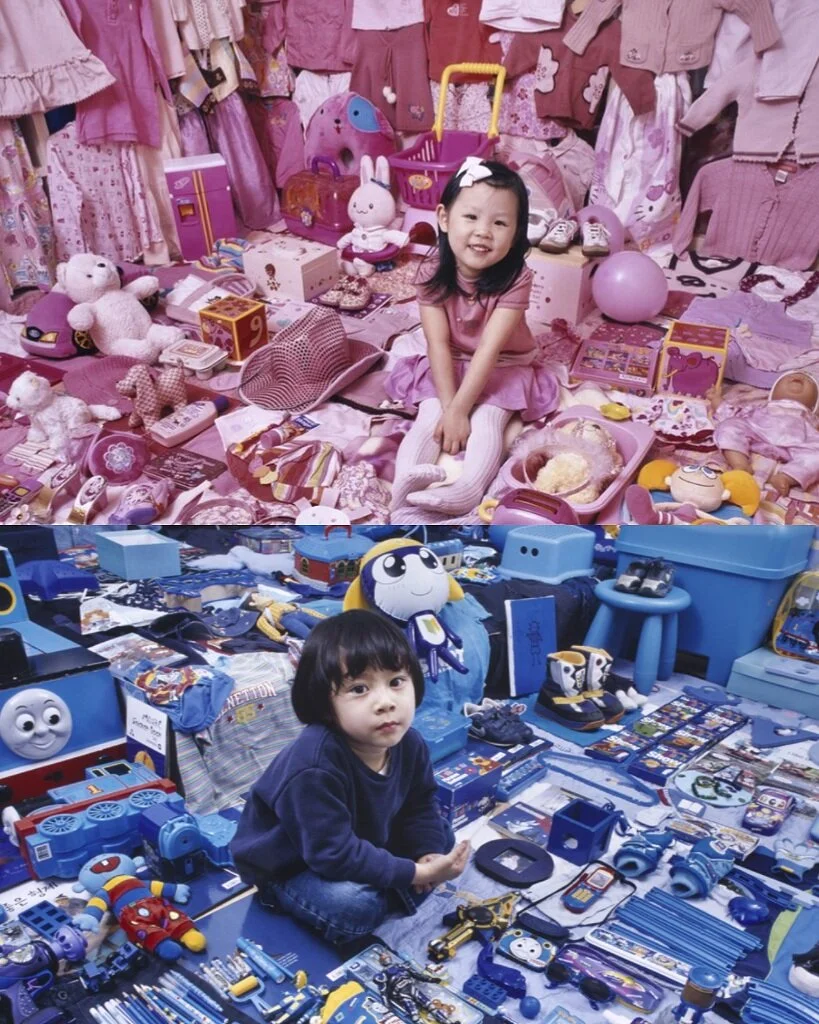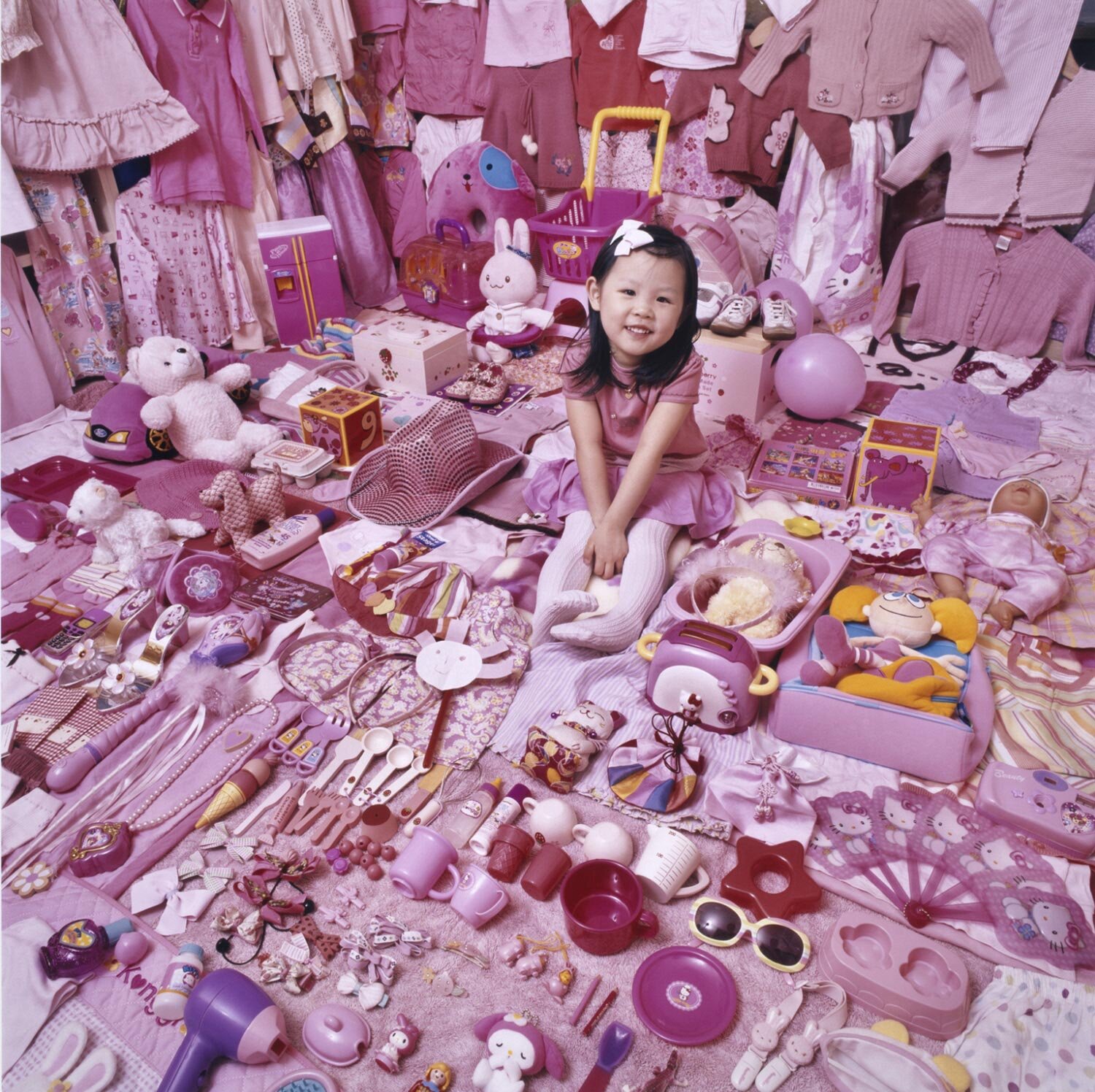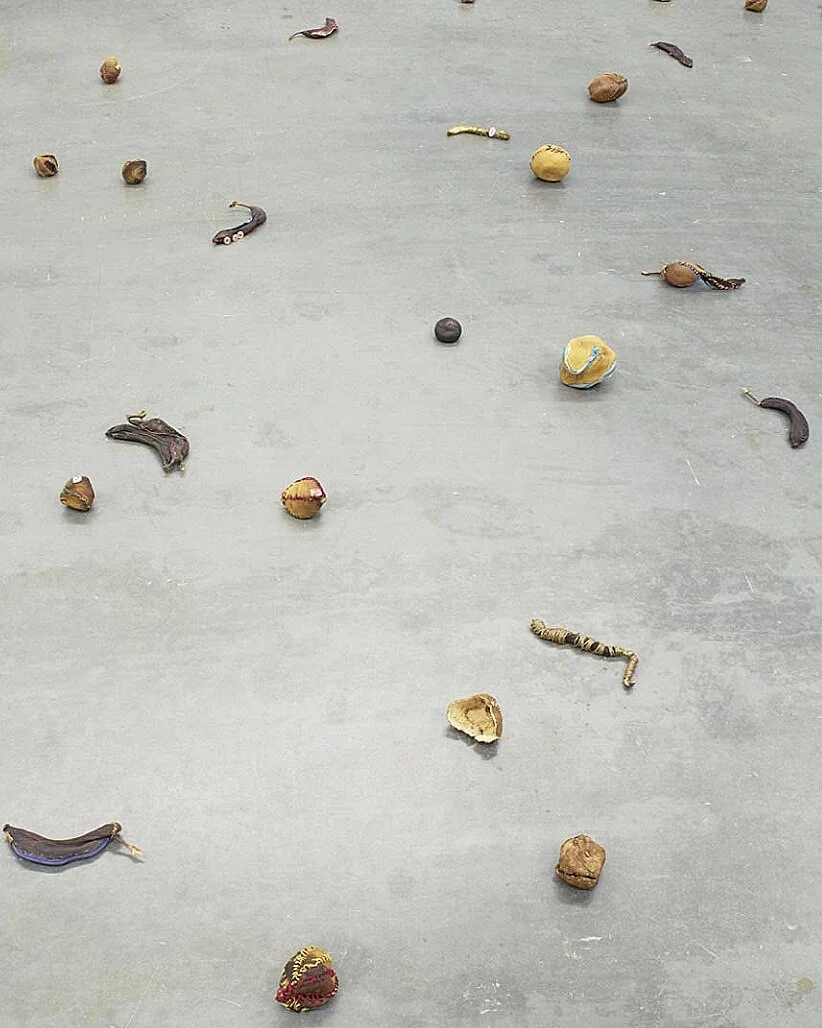Rx 24 / The Pink and Blue Project
“I wanted to re-think customized thinking in society. Why do we use color as a form of gender identity?”
- JeongMee Yoon
Intrigued by her daughter’s fixation on all things pink at an early age, contemporary mixed-media Korean artist JeongMee Yoon embarked on The Pink and Blue Project, a critique of binary gender identity as determined by and reflected in rampant consumerism. In 2005, Yoon began to stage photo shoots of young children in Seoul and New York to convey the cross-cultural phenomenon of gender color preference and further probe the relationships between gender and globalization, societal values, and material culture. Each photograph in the ongoing portrait series features a solitary child situated amidst a meticulously curated, massive catalog of possessions. Yoon intentionally scales the objects by size and color to convey an unsettling and almost frightening sense of material excess. “I am fascinated by the accumulation of things,” explained the artist.
“I am fascinated by the accumulation of things.”
In the fifteen years since the project’s inception, Yoon has captured over seventy children in their homes and revisited many at various intervals to document their evolution from childhood to teenage years. When viewed in series, a secondary theme emerges beyond the binary color coding. Confectionary pink toys and dresses emphasize domesticity and fashion for girls, whereas technology and science-related blue toys surround the boys, echoing Yoon’s experiences browsing children’s sections in mega-stores like Walmart and observing the pre-codified toys and clothing. To further intensify the “objectification” of gender expectations, the children in Yoon’s portraits were instructed to sustain a blank, doll-like expression for the shoot. In doing so, Yoon turns a critical eye to the mechanisms of mass consumption and over-determined gender imposed at a young age, an articulation of what scholar Judith Butler has termed the “performativity” of binary gender. Yoon notes that by third or fourth grade, girls’ gravitation towards pink begins to fade. Portraits of the little girls above and their “pink things” shift to a rainbow of color four years later, yet the behavioral patterns instilled at a young age persist.
reflections…
The Pink and Blue Project provides a window into the unfettered consumption and materialism of upper-class Korean society in the early 2000s—a scene that clashes obscenely with our current moment of unprecedented unemployment, poverty, and material scarcity in the United States. In this way, Yoon joins a multi-generational lineage of cultural commentary about class difference and consumerism n. In the 1980s, for example, cultural anthropologist Arjun Appadurai posited that our things have “social lives,” and that an individual’s material culture tells us something profoundly important about who they are and the values their society espouses. More polemically, the French artist Guy Debord famously argued in The Society of the Spectacle (1967) that in a capitalist society such as ours, all life revolves around the consumption of objects.
To what extent do we recognize ourselves in Yoon’s pictures and do they challenge or reinforce consumer-driven tendencies? How does a similar, ongoing tension between excess and scarcity exist in the healthcare sector? American hospitals, in particular, are sites of extraordinary expenditure and mass consumption. How do clinicians negotiate a profit-driven, incentivized system and the extravagance of institutional spending, in relation to the millions of uninsured people who cannot access basic care?
Doctors often have complex professional and personal relationships to matters of compensation and consumption. Just as physician and healthcare team relations may be encumbered by compensation stratification across subspecialties and scope of practice, patient care is frequently marked by profound class differences. How do these divisions overshadow peer and team dynamics as well as the patient encounter, potentially creating barriers to connection and effective care? How can physicians become more self-aware about class identity to foster a collegial working environment and provide more empathetic care? How can we better motivate students and trainees to pursue traditionally less lucrative fields such as primary care and pediatrics by reframing the concept of success in medicine? How might a tuition-free model for medical school, such as the one in place at the New York University Grossman School of Medicine, extricate the burden of medical student debt driving subspecialty consideration and reshape the pipeline for diverse applicants entering into various fields?
As The Pink and Blue Project illustrates, gender identity is a process of development and socialization. So too is professional identity formation (PIF) in medical education, or the complex transition from lay person to physician, which is gradual and shaped almost entirely by instruction, reinforcement, and external contexts . Once deemed innate, characteristics such as the capacity for reflection, communication, and self-awareness are now regarded as core proficiencies in medical education. In this way, PIF is foundational to self-transformation and a key-driver in the development of a humanistic physician. The question of “how do medical students and trainees come to think, act, and feel like a physician” echoes Yoon’s visual treatise on customized thinking and the impact of continuous, reinforced exposure to external influences during formative periods.
How can medical educators rise to the challenges of longitudinal engagement with students and residents to help actively construct their evolving professional identity across the continuum of training? How do we better support and assess the transition from learner to practitioner through various pedagogical methods that embody and embrace the essential elements of PIF?
sources
Cruess RL, Cruess SR, Boudreau JD, Snell L, Steinert Y. A schematic representation of the professional identity formation and socialization of medical students and residents: a guide for medical educators. Acad Med. 2015;90(6):718-725. doi:10.1097/ACM.0000000000000700.
Kalet A, Buckvar-Keltz L, Monson V, , et al. 2018, 'Professional Identity Formation in medical school: One measure reflects changes during pre-clerkship training', MedEdPublish, 7, [1], 41, https://doi.org/10.15694/mep.2018.0000041.1.
Macdonald, Kerri. “Pink or Blue Toys for Girls and Boys.” The New York Times. The New York Times, October 13, 2014. https://lens.blogs.nytimes.com/2014/10/13/pink-or-blue-toys-for-girls-and-boys/.
Rosenberg, David. “Incredible Portraits of Kids' Rooms: Pink Is for Girls, Blue Is for Boys.” Slate Magazine. Slate, April 9, 2013. https://slate.com/culture/2013/04/jeongmee-yoon-the-pink-and-blue-project-examines-the-gender-specific-marketing-for-boys-and-girls-photos.html.
Wald, H, Anthony, D, Hutchinson, T, et al. ‘Professional Identity Formation in Medical Education for Humanistic, Resilient Physicians,’ Acad Med. 2015;90(6): 753-760. doi: 10.1097/ACM.0000000000000725.
“A Study of Gender and Colour over 14 Years: JeongMee Yoon on The Pink and Blue Project.” It's Nice That. Accessed December 17, 2020. https://www.itsnicethat.com/features/jeongmee-yoon-the-pink-and-blue-project-photography-040319.
“SVA Alumnus and Photographer JeongMee Yoon Focuses on People and Their Possessions.” SVA. Accessed December 17, 2020. https://sva.edu/features/sva-alumnus-and-photographer-jeongmee-yoon-focuses-on-people-and-their-possessions.
TEDTalentSearch. “Jeongmee Yoon: An Artist Explores Little Girls' Love of Pink.” YouTube. YouTube, July 5, 2012. https://www.youtube.com/watch?v=IFXMTUcUi44.
“When Did Girls Start Wearing Pink?” Smithsonian.com. Smithsonian Institution, April 7, 2011. https://www.smithsonianmag.com/arts-culture/when-did-girls-start-wearing-pink-1370097/.
Yoon, JeongMee. “The Pink & Blue Project : (2005-Ongoing).” JeongMee Yoon's official website. Accessed December 15, 2020. http://www.jeongmeeyoon.com/aw_pinkblue.htm.















